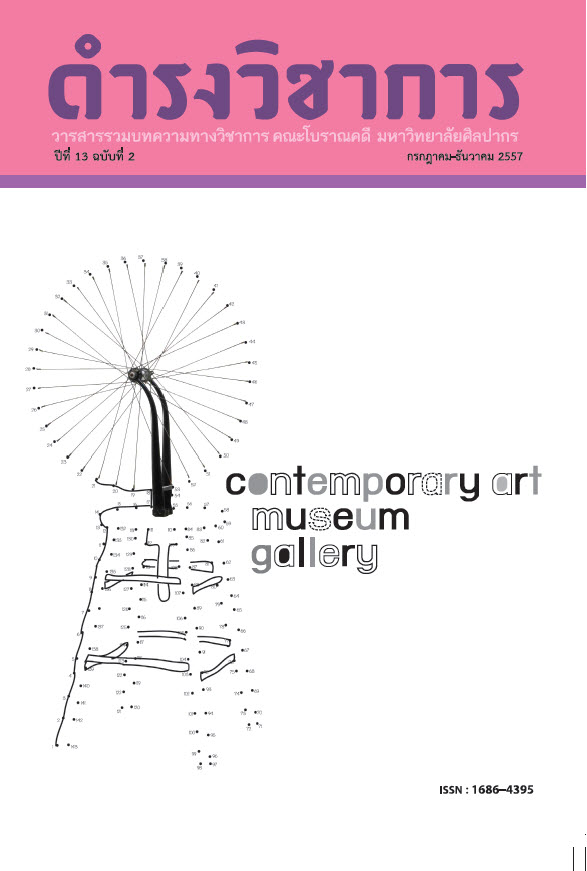Cabinet of Thai Identity: Museum Space in Cultural and Political Context
Keywords:
Institution critique, Museum space, Exhibition, Thai identityAbstract
The Nitasrattanakosin Exhibition Hall (Rattanakosin Exhibition), the Queen Sirikhit Museum of Textiles, and Sin Phaen Din (Art of the Kingdom) at the Ananta Samakhom Throne Hall are all recent exhibitions which display the history of Bangkok, the invention of the formal Thai national costume and the traditional arts and crafts of Thailand, respectively. This study aims to analyse the visualisation of Thai national identity or ‘Thainess’ through the collective memories of Thai history, sartorial reform and the works of art shown in the aforementioned exhibitions. Moreover, the locations these museums or exhibitions occupy, including their buildings, are very significant both historically and politically. They were initially constructed by the commissions of King Chulalongkorn (King Rama V), the embodiment of the notion of ‘Populist King’ in Thailand’s official history and the absolutist monarch. Except for the building of the Nitasrattanakosin, however, Ratchadamnoen Avenue where its building locates also built by King Chulalongkorn. This space was designed to distribute the power of monarchy under the absolute monarchy regime until the 1932 Revolution when the democracy was established and replaced the old regime. In more recent times, this space, especially the Ratchadamnoen Avenue, including the Royal Plaza have been used frequently in political rallies. Thus this paper aims to articulate the relationship between concrete geographical sites and historical circumstances through the exhibitions.
References
ชาตรี ประกิตนนทการ, 2550ก. การเมืองและสังคมในศิลปสถาปัตยกรรม สยามสมัย ไทยประยุกต์ ชาตินิยม. พิมพ์ครั้งที่ 2. กรุงเทพฯ: มติชน.
ชาตรี ประกิตนนทการ, 2550ข. “ความทรงจําาและอําานาจบนถนนราชดําาเนิน.” เมืองโบราณ 33 (4) 67-86.
“ประกาศจัดที่สร้างถนนราชดําาเนิน,” 2442. ราชกิจจานุเบกษา เล่ม 16 ตอน 22 (วันที่ 27 สิงหาคม): 276-279.
ประชา สุวีรานนท์, 2554. อัตลักษณ์ไทย: จากไทยสู่ไทยๆ. กรุงเทพฯ: ฟ้าเดียวกัน.
พระบาทสมเด็จพระมงกุฎเกล้าเจ้าอยู่หัว, 2506. ลัทธิเอาอย่างและโคลนติดล้อ. กรุงเทพฯ: กรมศิลปากร.
ยาสุกิจิ ยาตาเบ, 2550. บันทึกของทูตญี่ปุ่น ผู้เห็นเหตุการณ์ปฏิวัติ 2475: การปฏิวัติและการเปลี่ยนแปลงในประเทศสยาม. (แปลโดย เออิจิ มูราชิมา และนครินทร์ เมฆไตรรัตน์). กรุงเทพฯ: มติชน.
“รายงานการสร้างอนุสาวรีย์ประชาธิปไตย,” 2483. ราชกิจจานุเบกษา เล่ม 57 (วันที่ 24 มิถุนายน): 870-876.
เลิศลักษณา ยอดอาวุธ, เทอดศักดิ์ ร่มจําาปา, สุวิชญ์ หาญดํารงค์รักษ์ และเอนก มากอนันต์, 2555. นิทรรศน์รัตนโกสินทร์อัญมณีแห่งมหานคร. กรุงเทพฯ: สํานักงานทรัพย์สินส่วนพระมหากษัตริย์. ค้นเมื่อ 27 มิถุนายน 2555, จาก http://www.nitasrattanakosin.com/download_page.php?src=download059.pdf
สถาบันสิริกิติ์ สวนจิตรลดา, 2555. นิทรรศการ: ชิ้นงานสําาคัญที่จัดแสดง. ค้นเมื่อ 21 มกราคม 2557, จาก http://www.artsofthekingdom.com/th/index.php?page=product_main
สมเด็จพระนางเจ้าสิริกิติ์ พระบรมราชินีนาถ, 2547. ความทรงจําในการตามเสด็จต่างประเทศทางราชการ. พิมพ์ครั้งที่ 2. กรุงเทพฯ: มูลนิธิไทยช่วยไทย.
สายชล สัตยานุรักษ์, 2546. สมเด็จฯ กรมพระยาดําารงราชานุภาพ: การสร้างอัตลักษณ์ “เมืองไทย” และ “ชั้น” ของชาวสยาม. กรุงเทพฯ: มติชน.
สายชล สัตยานุรักษ์, 2548. “การสร้าง “ความเป็นไทย” กระแสหลัก และ “ความจริง” ที่ “ความเป็นไทย”สร้าง.” ค้นเมื่อ 7 สิงหาคม 2555, จาก http://thai-library.org/Resource/0000001026.pdf
Alpers S., 1991. “The Museum as a Way of Seeing.” In I. Karp & S.D. Lavine (eds.), Exhibiting Cultures: The Poetics and Politics of Museum Display (pp. 25-32). Washington: Smithsonian Institution Press.
Benjamin W., 1999. “The Work of Art in the Age of Mechanical Reproduction.” In H. Arendt (ed.), Illuminations (pp. 211-244). 2nd ed. London: Pimlico.
Bennett T., 1995. The Birth of the Museum: History, Theory, Politics. London: Routledge.
Duncan C., 1991. “Art Museums and the Ritual of Citizenship.” In I. Karp & S.D. Lavine (eds.), Exhibiting Cultures: The Poetics and Politics of Museum Display(pp. 88-104). Washington: Smithsonian Institution Press.
Duncan C., 1998. “The Art Museums as Ritual.” In D. Prezionsi (ed.), The Art of Art History: A Critical Anthology (pp. 473-485). Oxford: Oxford University Press.
Elden S., 2007. “There is a Politics of Space because Space is Political: Henri Lefebvre and the Production of Space.” Radical Philosophy Review 10 (2): 101-116.
Google Maps, 2014. Grand Palace, Na Phra Lan Rd, Phra Nakhon, Bangkok,Thailand. Retrieved May 11, 2014, from https://www.google.co.uk/maps/place/Grand+Palace/@13.750335,100.491535,17z/data=!3m1!4b1!4m2!3m1!1s0x30e2990f1400adc9:0xc7c8e2e28e73a435?hl=en
Hobsbawm E., 2013. “Introduction: Inventing Traditions.” In E. Hobsbawm & T. Ranger (ed.), The Invention of Tradition (pp. 1-14). 21st ed. Cambridge: Cambridge University Press.
Karp I. & Lavine S.D. (eds.), 1991. Exhibiting Cultures: The Poetics and Politics of Museum Display. Washington: Smithsonian Institution Press.
Lefebvre H., 1991. The Production of Space. (Translated by D. Nicholson-Smith). Oxford: Blackwell Publisher.
Parkins W., 2002. Fashioning the Body Politics: Dress, Gender, Citizenship. Oxford: Berge.
Reynold C.J. (ed.), 2002. National identity and its defenders: Thailand Today. Chiang Mai: Silkworm Books.
Roces M. & Edwards L. (eds.), 2008. The Politics of Dress in Asia and The Americas. Brighton: Sussex Academic Press.
Soja E.W., 1990. Postmodern Geographies: The Reassertion of Space in Critical Social Theory. 2nd ed. London: Verso.
Downloads
Issue
Section
License
บทความนี้เป็นผลงานของข้าพเจ้าแต่เพียงผู้เดียว และ/หรือเป็นผลงานของข้าพเจ้าและผู้ร่วมงาน ตามชื่อที่ระบุในบทความจริง และเป็นผลงานที่มิได้ถูกนำเสนอหรือตีพิมพ์ที่ใดมาก่อน





